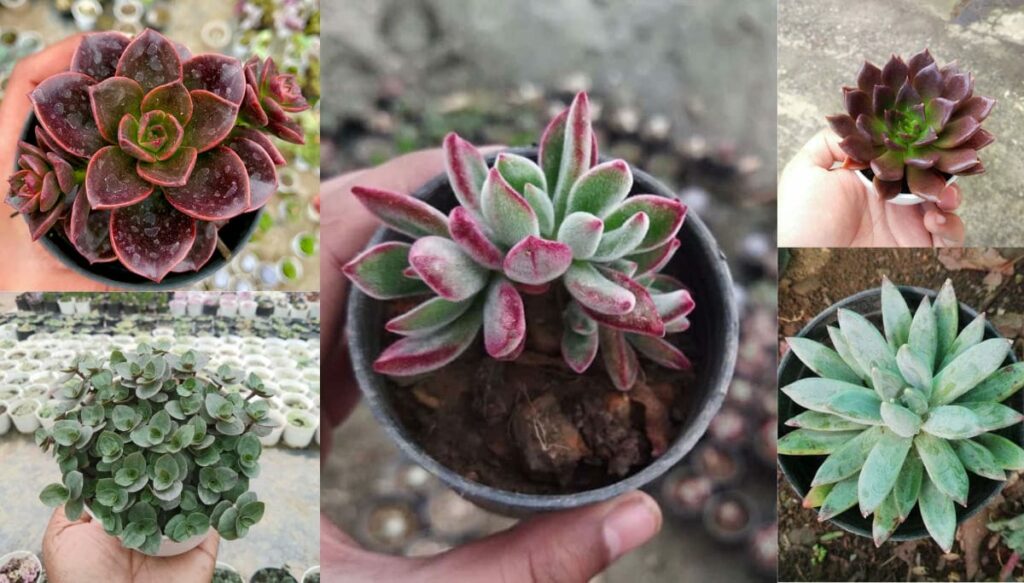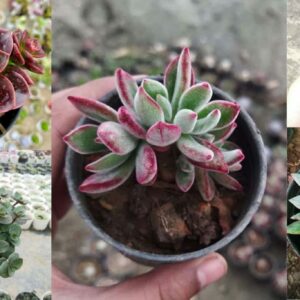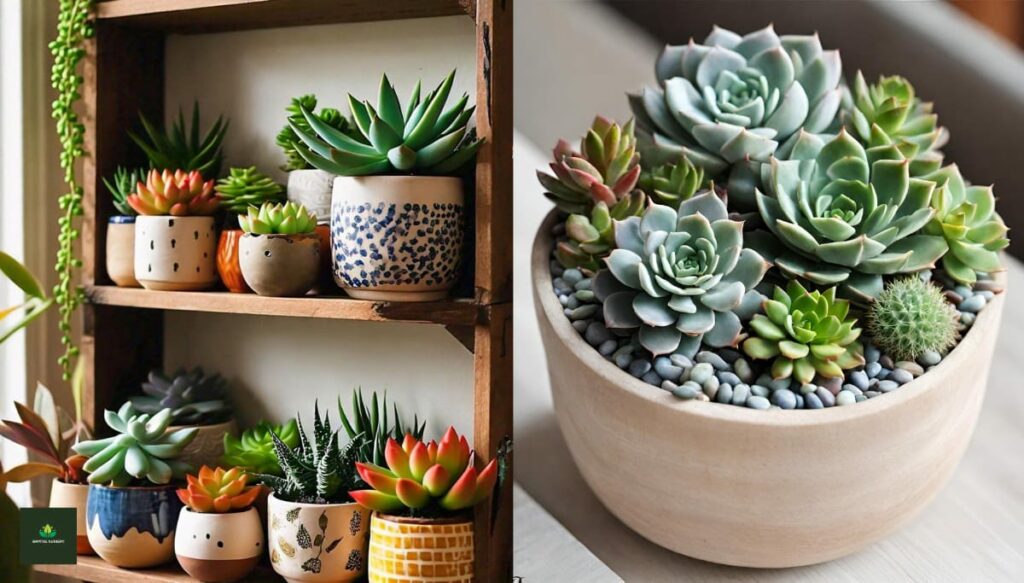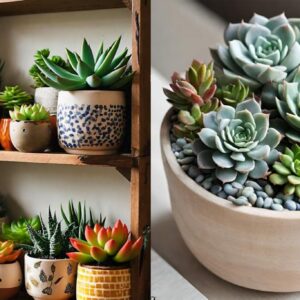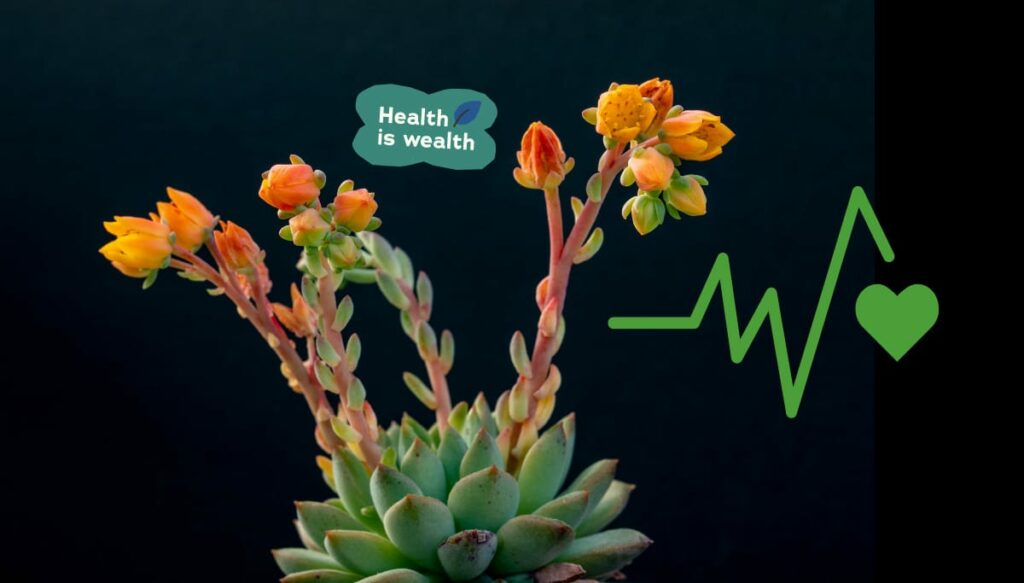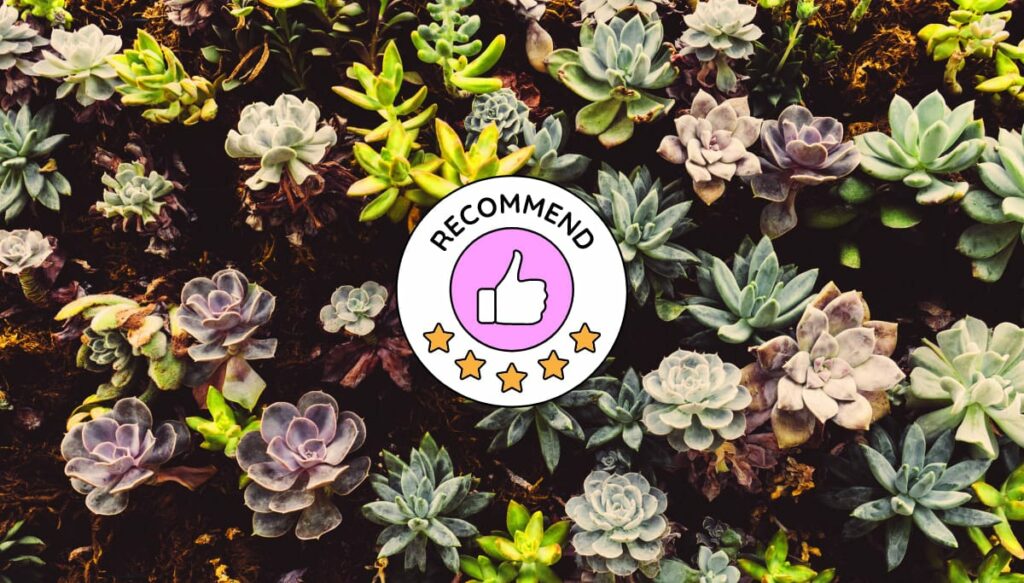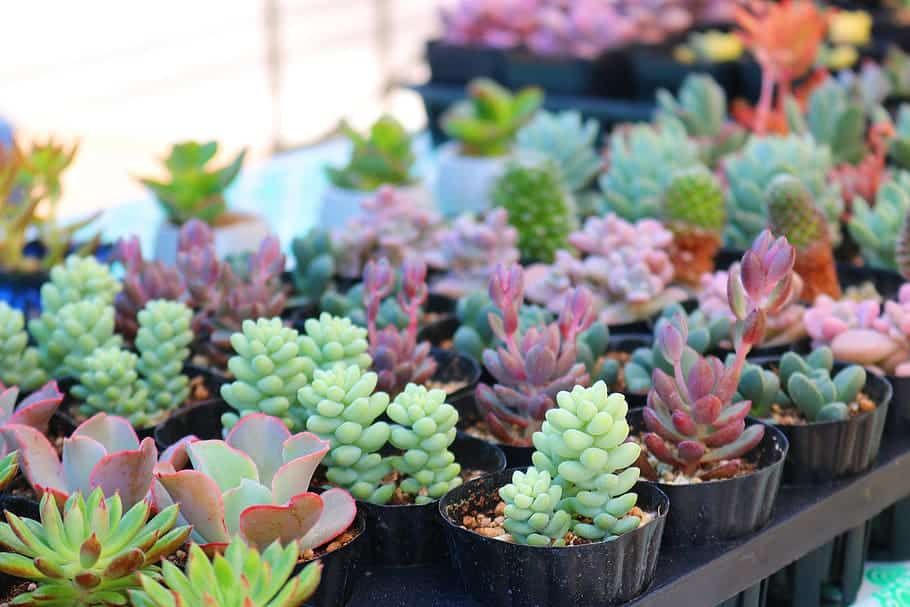
List of Indoor succulent plants : Succulents are an excellent way to add a touch of greenery and life to your home, even if you don’t have a green thumb. These low-maintenance plants require minimal care and come in various shapes, sizes, and colors. They’re perfect for indoor spaces because they can survive without direct sunlight or frequent watering.
In this blog post, we’ll take a closer look at the best types of indoor succulent plants that will thrive in any space with proper care. Whether you’re an experienced gardener or new to plant parenting, these hardy plants are sure to brighten up your home décor!
Types of Indoor Succulent Plants
Succulent plants come in various shapes, sizes, and colors. In this section, we’ll explore the best types of indoor succulents that will thrive in any home.
Aloe Plants
First on our list is the Aloe plant. This popular succulent and easy-to-care-for nature. It’s also a natural air purifier that helps to remove harmful toxins from your living space.
- Aloe succotrina Lam “Fynbos aloe”
- Aloe Christmas Carol Succulent
- Aristaloe aristata cv. ‘Cosmo’ (Variety 1) “Lace Aloe”
- Aloe aristata (Variety 1) “Lace aloe”
- Aloe Juvenna “Tiger Tooth Aloe” Succulent Plant
- Aloe Aristata “Lace Aloe”
- Gasteria carinata (Mill.) Duval “Roundtip aloe”
Echeveria Plants
Another great option is the Echeveria. These rosette-shaped plants are incredibly versatile and come in a wide range of colors, including green, blue-gray, pink, and purple. They require bright light but can also tolerate low-light conditions.
- Echeveria elegans Rose (Variety 5) “Pearl echeveria”
- Echeveria pulvinata Rose “Chenilleplant”
- Echeveria secunda Booth ex Lindl. “Blue Echeveria”
- Vishnu Kamal – Echeveria purpusorum (Variety 1)
- Echeveria ‘Doris Taylor’ – Woolly Rose
- Echeveria Perle Von Nurnberg Succulent | Pink Rosette
- Echeveria Blue Sky Succulent
- Echeveria Green Spoon Succulent
- Echeveria Melaco Succulent Plant
- Echeveria Fire Pillar Succulent Plant
- Echeveria secunda “Blue Echeveria”
- Echeveria Desmetiana Succulent Plant
- Echeveria colorata E.Walther
- Echeveria Runyonii Topsy Turvy Succulent
- Echeveria Gibbiflora “Perle Von Nurnberg”
- Echeveria Spica Succulent
- Echeveria Secunda Booth “Blue Echeveria”
- Echeveria elegans Rose (Variety 2) “Pearl echeveria”
- Echeveria colorata E.Walther “Red top queen”
- Echeveria Rolly – Sedeveria Rolly Korean Succulent
- Echeveria pulidonis E.Walther “Pulido’s Echeveria”
- Echeveria Hookeri Succulent
- Echeveria elegans Rose(Variety 1) “Pearl echeveria”
- Echeveria pallida
- Echeveria shaviana
Hanging Plants
If you’re looking for a hanging plant option, consider String of Pearls or Burro’s Tail succulents. These trailing plants look stunning when hung from baskets or shelves and add an interesting texture to any room.
- English Ivy
- String of Pearls
- Variegated String of Pearls
- Senecio herreianus Dinter “String of bananas”
- Crassula Muscosa (Toy-cypress) Chain Succulent
- Sedum sexangulare (Tasteless stonecrop)
- Sedum Japonicum Siebold (Tokyo Sun)
- Othonna capensis L.H.Bailey (Little pickles)
- Sedum burrito Moran “Donkey Tail”
- Sedum hispanicum (Spanish stonecrop)
- String of hearts / String Of Heart
- Crassula perforata Thunb. “String of buttons”
- Crassula perforata “String of buttons”
Aeonium Plants
Aeonium, also known as Tree Houseleek, is a genus of flowering succulent plants that are native to the Canary Islands, Morocco and East Africa. The most common species of Aeonium has rosettes of fleshy, spoon-shaped leaves which are arranged on stems that can vary in height from a few inches to several feet. The leaves may be green or various shades of red, purple, and black, depending on the amount of sunlight, temperature, and moisture.
Aeonium is a relatively easy plant to grow and care for. It prefers bright, indirect sunlight and well-draining soil. Overwatering should be avoided, as it can cause root rot. Instead, the plant should be watered deeply but infrequently, allowing the soil to dry out completely between waterings. Aeoniums are ideal for container gardening and can be grown in pots or other containers that provide good drainage.
- Aeonium haworthii Webb & Berthel “Haworth’s aeonium”
- Aeonium haworthii Webb (Variety 2) “Haworth’s aeonium”
- Aeonium Arboreum Webb “Tree aeonium”
- Aeonium arboreum (Variety 1)
- Aeonium arboreum “Tree aeonium”
- Aeonium haworthii Webb (Variety 1) “Haworth’s aeonium”
- Aeonium castello-paivae Bolle “Lily paddy”
- Aeonium castello-paivae Bolle
- Aeonium haworthii Webb & Berthel.(Variety 1) “Haworth’s aeonium”
Kalanchoe Plants
Kalanchoe is a genus of succulent plants that are native to Madagascar and other parts of Africa. They are known for their bright and colorful flowers, which bloom in clusters on tall stems. The leaves of Kalanchoe plants are generally thick and fleshy, and can be either flat or lobed depending on the species.
Kalanchoe plants require bright, indirect sunlight and well-draining soil. Overwatering should be avoided, as it can cause root rot. Instead, the plant should be watered deeply but infrequently, allowing the soil to dry out completely between waterings. Kalanchoe is also relatively low-maintenance when it comes to fertilization, as it typically only needs to be fertilized once every two to three months.
- Kalanchoe Tomentosa Baker “Panda plant”
- Kalanchoe Tomentosa “Chocolate Soldier” Plant
- Kalanchoe Tomentosa Panda Plant Succulent
- Kalanchoe laxiflora Baker(Variety 1) “Milky widow’s thrill”
- Kalanchoe laxiflora Baker “Milky widow’s thrill”
- Kalanchoe marnieriana H. Jacobsen(Variety 1)”Marnier’s Kalanchoe”
- Kalanchoe marnieriana H. Jacobsen
- Kalanchoe Flapjack, Poplet Succulent Plant
- Kalanchoe serrata Mannoni & Boiteau “Magic Tower”
- Kalanchoe blossfeldiana Poelln “Flaming katy”
Crassula Plants
Crassula is a large genus of succulent plants native to many parts of the world, including South Africa, Madagascar, and Asia. They are known for their attractive rosette formations and thick, fleshy leaves that can vary in shape and color depending on the species.
Crassula plants require bright, indirect sunlight and well-draining soil. Overwatering should be avoided, as it can cause root rot. Instead, the plant should be watered deeply but infrequently, allowing the soil to dry out completely between waterings. Crassula is also relatively low-maintenance when it comes to fertilization, as it typically only needs to be fertilized once every two to three months.
- Crassula Ovata
- Crassula capitella Thunb – “Campfire Plant”
- Crassula Sarmentosa Harv
- Crassula tetragona L.(Karkai)
- Crassula Capitella (Red Pagoda)
- Crassula Muscosa (Toy-cypress) Chain Succulent
- Crassula ovata (Mill.) Druce(Variety 1) “Jade plant”
- Crassula Capitella Thunb. (Variety 1) “Campfire plant”
- Crassula lactea Aiton
- Crassula capitella Thunb “Campfire plant”
- Crassula humberti
- Crassula perforata Thunb. “String of buttons”
- Crassula perforata “String of buttons”
- Sinocrassula yunnanensis (Franch.) A. Berger “Chinese Jade”
- Crassula lunuginosa v pachystemon David
- Crassula mesembryanthemoides “Cats tongue”
- Sedum adolphii Raym.-Hamet (Sedum “Firestorm”)
Haworthia Plants
Haworthia is a genus of small succulent plants that are native to Southern Africa. They are known for their attractive, rosette-shaped leaves that can be green or variegated with white stripes or spots. Haworthia plants are often confused with a related genus, Aloe, but they can be distinguished by their shorter, fatter leaves and smaller size.
Haworthia plants require bright, indirect sunlight and well-draining soil. Overwatering should be avoided, as it can cause root rot. Instead, the plant should be watered deeply but infrequently, allowing the soil to dry out completely between waterings. Haworthia is also relatively low-maintenance when it comes to fertilization, as it typically only needs to be fertilized once every two to three months.
- Haworthia cymbiformis “Cathedral Window”
- Haworthia cymbiformis “Cathedral Window”
- Haworthia reinwardtii (Salm-Dyck) Haw. “Frosted claw”
- Haworthia attenuata “Zebra Haworthia”
- Haworthia Attenuata “Zebra Haworthia”
- Haworthia fasciata “Zebra haworthia”
- Haworthia limifolia Marloth “Fairy washboard”
Sempervivum Plants
Sempervivum, also known as Houseleeks or Hens and Chicks, is a genus of succulent plants native to Europe and Asia. They are commonly grown for their attractive, rosette-shaped leaves that can range in color from green to purple to red, and often feature fuzzy hairs or small hairs along the edges of the leaves.
Sempervivum plants require bright, indirect sunlight and well-draining soil. Overwatering should be avoided, as it can cause root rot. Instead, the plant should be watered deeply but infrequently, allowing the soil to dry out completely between waterings. Sempervivum is also relatively low-maintenance when it comes to fertilization, as it typically only needs to be fertilized once every two to three months.
- Golden Luck Succulent Plant (Sempervivum Tectorum)
- Sempervivum arachnoideum “Cobweb house-leek”
- Sempervivum arachnoideum (Variety 1) “Cobweb house-leek”
- Sempervivum Silver Thaw succulent plant
- Sempervivum tectorum (Variety 1) “Hen-and-chickens”
- Sempervivum tectorum (Variety 1) “Laxmi Kamal”
- Sempervivum arachnoideum “Cobweb house-leek”
- Sempervivum tectorum “Hen-and-chickens”
- Sempervivum calcareum “Red Tipped Houseleek”
- Sempervivum Silver Thaw
Sedum Plants
Sedum is a versatile and hardy plant that belongs to the Crassulaceae family. With over 400 different species, it can be found in almost every corner of the world, from arctic tundras to dry deserts. The most common variety of Sedum is known for its succulent leaves and small, star-shaped flowers that bloom during late summer or early fall. This low-maintenance plant requires minimal watering and thrives in bright sunlight or partial shade.
It’s perfect for rock gardens or as ground cover due to its ability to spread quickly without becoming invasive. Additionally, Sedum has medicinal properties and can be used in herbal remedies as an anti-inflammatory agent or to help reduce stress levels. From its resilience in harsh environments to its aesthetic appeal, there’s no denying the versatility of this fascinating plant!
- Sedum Album “White Stonecrop”
- Sedum Rubrotinctum (Jelly Beans) Succulent Plant
- Sedum adolphii Raym.-Hamet (Sedum “Firestorm”)
- Sedum Adolphi “Sedum “Firestorm”
- Sedum sexangulare (Tasteless stonecrop) Succulent
- Sedum burrito Moran “Donkey Tail”
- Sedum nussbaumerianum Bitter “Orange Delight”
- Sedum clavatum R.T. Clausen “Peas in a Pod”
- Sedum Adolphii Raym.-Hamet (Variety 1) Sedum “Firestorm”
- Sedum adolphii Raym.-Hamet (Sedum “Firestorm”) (Variety 1)
- Sedum craigi
- Graptosedum California Sunset
- Sedum clavatum “Peas in a Pod”
- Sedum clavatum “Peas in a Pod”
- Sedum Japonicum Siebold (Tokyo Sun)
- Sedum pachyphyllum Rose
- Sedum hispanicum (Spanish stonecrop)
Cacti / Cactus Plants
Don’t forget about Cacti! While not technically a succulent (they’re part of the same family), these prickly plants make excellent additions to any indoor garden due to their unique appearance and minimal watering needs.
There are many different types of indoor succulent plants available that can add beauty and life to your home decor while being easy to care for at the same time!
- Opuntia microdasys (Variety 1) “Bunny-ears prickly-pear”
- Opuntia microdasys (Variety 1) “Bunny-ears prickly-pear”
- Mammillaria elongata DC. “Golden star cactus”
- Mammillaria decipiens “Bird’s-nest pincushion”
- Pebbled Tiger Jaws Succulent (Faucaria Tuberculosa)
- Opuntia microdasys “Bunny-ears prickly-pear”
- Acanthocereus Tetragonus Variagata Cactus
- Mammillaria grahamii Engelm. “Graham’s fishhook cactus”
- Mammillaria Thornberi Orcutt “Cluster fishhook cactus”
- Gymnocalycium Baldianum “Thread Cactus”
- Mammillaria zeilmanniana Cactus
- Old-lady pincushion Cactus
- Gymnocalycium Mihanovichi
- Mammillaria vetula Mart
- Coville’s barrel cactus
- Moon Cactus (Orange)
- Brain Cactus
- Pincushion Cactus
- Cactus Z1
- Cactus Z2
- Little candles Cactus
- Golden Barrel Cactus
- Greenflower nipple cactus
- Mammillaria prolifera “Little candles”
- Mammillaria bombycina Quehl
- Echinopsis eyriesi “Eyries Cactus”
- Peruvian apple cactus
- Old-lady pincushion
- Tom Thumb Cactus
- Eyries Cactus
- Texas Cactus
- Silver Ball Cactus
View All Cactus – Click Here
Other Beautiful Succulent Plants
- Pachyphytum Compactum Succulent Plant
- Pachyphytum Compactum Rose “Little Jewel”
- Cotyledon tomentosa “Bear paw “
- Molded wax (Red)
- Molded wax
- Jade Plant (Variegated)
- Chinese Campfire plant
- Moon Stone Succulent
- Orostachys iwarenge Hara “Chinese Dunce Cap”
- Senecio serpens G.D.Rowley “Blue chalksticks”
- African emeralds
- Gibbaeum petrense Tischler
- Succisa Trichotocephala Baksay
- Succisa Trichotocephala Baksay (Variety 1)
- Agave Univittata “McKelvey’s century plant”
- Rosary Plant
- Tradescantia zebrina Bosse “Wandering jew”
- Tradescantia zebrina Bosse(Variety 1) “Wandering jew”
- Gasteria excelsa Baker
- Orbea semota
- Pachyphytum Bubble Gum
- Pebbled Tiger Jaws Succulent (Faucaria Tuberculosa)
- Gasteria pillansii Kensit
- Gasteria pillansii Kensit (Variety 2)
- Wandering jew
How to Care for Indoor Succulent Plants
One of the most appealing aspects of indoor succulent plants is that they are relatively easy to care for. However, there are a few key things you need to keep in mind when taking care of these beautiful plants.
Firstly, it’s important to remember that succulents thrive in bright sunlight. Place your plant near a south-facing window or under grow lights for at least six hours a day.
Secondly, be mindful not to over-water your succulent – this can quickly lead to root rot and other complications. Instead, allow the soil to dry out completely between watering sessions and limit watering during winter months.
Thirdly, make sure you’re using well-draining soil specifically formulated for cacti and succulents. This will ensure proper drainage and prevent water from sitting around the roots.
Fertilize your indoor succulent sparingly with a balanced fertilizer during their growing season (typically spring through summer). Following these tips will help ensure that your indoor succulent thrives!
Benefits of Indoor Succulent Plants
Indoor succulent plants are becoming increasingly popular as houseplants due to their low maintenance and unique appearance. But did you know they also provide several benefits beyond just aesthetics?
Firstly, indoor succulents can purify the air in your home by removing toxins such as formaldehyde and benzene. This makes them an excellent addition to any room, especially if you have allergies or respiratory issues.
Moreover, taking care of these plants can be a great stress-reliever. Many people find that tending to their indoor garden helps them relax and unwind after a long day.
In addition, growing indoor succulent plants can also improve your mood and mental health. Studies have found that being around nature has a positive effect on our well-being and even reduces symptoms of depression.
Owning indoor succulent plants is cost-effective compared to other types of houseplants since they require minimal watering and maintenance.
So not only do these unique little plants add beauty to your space but they also offer many benefits for both physical and mental health.
Where to buy Indoor Succulent Plants
Where to Buy Indoor Succulent Plants : Now that you know about the various types of indoor succulent plants and how to care for them, you might be wondering where to buy them. There are several options available both online and offline.
Online plant shop such as Bhimtal Nursery offer a wide range of indoor succulents that can be delivered right at your doorstep. We Bhimtal Nursery offers wide verity of succulent and cactus plants at affordable price, All India Door step Delivery, Free & Easy Replacement / Refund if plants damaged during Transit.
Visit – Our Store
If you prefer seeing the plants in person before purchasing them, visit your local nursery or gardening store. Adding indoor succulent plants to your home is an excellent way to enhance its aesthetics while providing numerous benefits like air purification and stress relief. With proper care and attention, these low-maintenance beauties will thrive indoors all year round!
